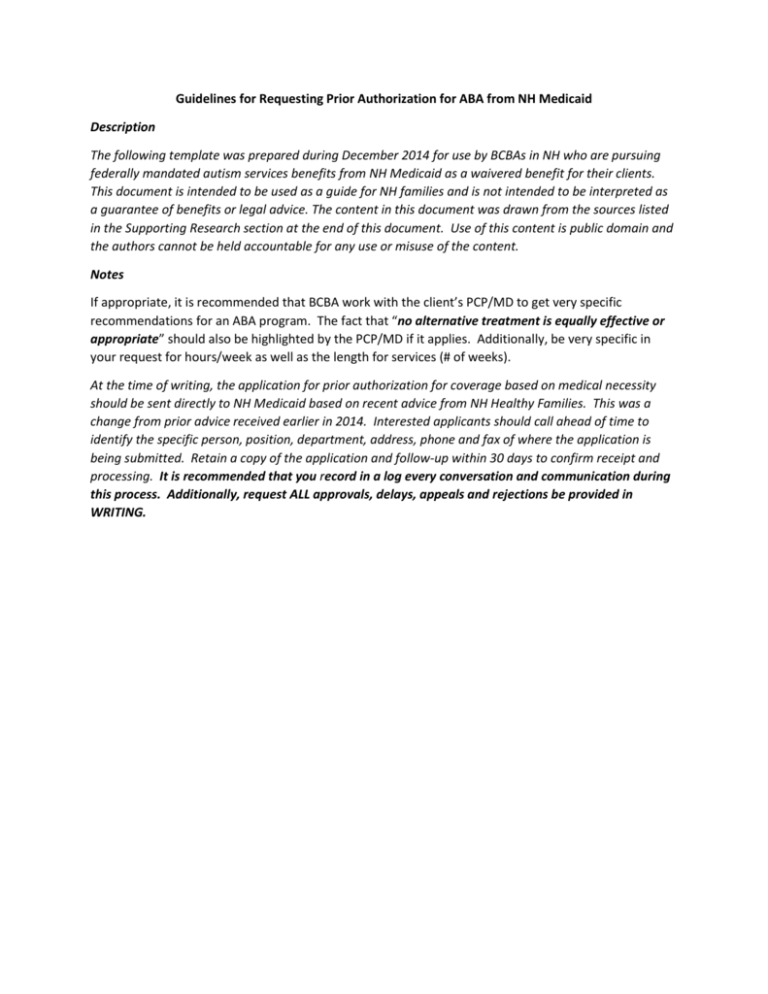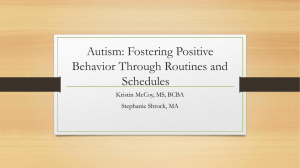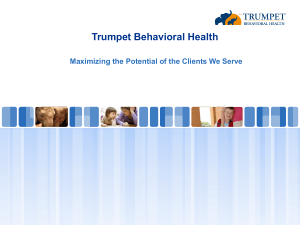File - Constellations Behavioral Services
advertisement

Guidelines for Requesting Prior Authorization for ABA from NH Medicaid Description The following template was prepared during December 2014 for use by BCBAs in NH who are pursuing federally mandated autism services benefits from NH Medicaid as a waivered benefit for their clients. This document is intended to be used as a guide for NH families and is not intended to be interpreted as a guarantee of benefits or legal advice. The content in this document was drawn from the sources listed in the Supporting Research section at the end of this document. Use of this content is public domain and the authors cannot be held accountable for any use or misuse of the content. Notes If appropriate, it is recommended that BCBA work with the client’s PCP/MD to get very specific recommendations for an ABA program. The fact that “no alternative treatment is equally effective or appropriate” should also be highlighted by the PCP/MD if it applies. Additionally, be very specific in your request for hours/week as well as the length for services (# of weeks). At the time of writing, the application for prior authorization for coverage based on medical necessity should be sent directly to NH Medicaid based on recent advice from NH Healthy Families. This was a change from prior advice received earlier in 2014. Interested applicants should call ahead of time to identify the specific person, position, department, address, phone and fax of where the application is being submitted. Retain a copy of the application and follow-up within 30 days to confirm receipt and processing. It is recommended that you record in a log every conversation and communication during this process. Additionally, request ALL approvals, delays, appeals and rejections be provided in WRITING. Example He-W 546.06 Application Language To Whom It May Concern: This is a request for prior authorization for NH Medicaid coverage of medically necessary ABA Treatment for the below individual under He-W 546.06: Prior Authorization for Coverage Based on Medical Necessity. (1) The recipient’s name, address, and Title XIX identification number; Client Name: Address: Title XIX ID Number / NH Medicaid Number: (2) The recipient’s diagnosis and prognosis, including an indication of whether the diagnosis is a pre-existing condition or a presenting condition; Diagnosis: Autism 299.00 Prognosis: Example: If untreated, X will likely fail to gain functional communication, safety awareness, self-help skills, social/play skills, and the ability to learn and participate within their environment. These potential outcomes can result in more intensive needs and services long term across his/her life span. Pre-existing or Presenting Diagnosis: Pre-existing (3) An estimation of the effect on the recipient if the requested service is not provided; Without ABA intervention being implemented as soon as possible, the optimal outcomes of ABA as shown by peer-reviewed research are not likely to manifest in this individual. These outcomes include that a high percentage of those “who had received intensive ABA scored in the normal range on measures of IQ and adaptive behavior and were able to transition to regular education with no support.” Older children also show significant benefits in the form of decreased self-injurious and aggressive behaviors, increased social skills, and more independent functioning in daily living. (4) The medical justification for the services or equipment being requested; Example: A Comprehensive ABA Program is medically necessary to correct or ameliorate the client’s condition. ABA is the design, implementation, and evaluation of environmental modifications to produce socially significant improvement in human behavior. ABA includes the use of direct observation, measurement, and functional analysis of the relations between environment and behavior. ABA uses changes in environmental events, including antecedent stimuli and consequences, to produce practical and significant changes in behavior. These relevant environmental events are usually identified through a variety of specialized assessment methods. ABA is based on the fact that an individual’s behavior is determined by past and current environmental events in conjunction with organic variables such as their genetic endowment and ongoing physiological variables. ABA focuses on treating behavioral difficulties by changing the individual’s environment rather than focusing on variables that are, at least presently, beyond our direct access. A Comprehensive ABA Program includes 25-40 hours of intervention per week by highly qualified staff demonstrating competencies in ABA implementation and delivery. The successful remediation of core deficits of ASD, and the development or restoration of abilities, documented in hundreds of peer-reviewed studies published over the past 50 years has made ABA the standard of care for the treatment of ASD.” -Behavior Analyst Certification Board (BACB) (5) The recommended timetable of the prescribed treatment; ABA Therapy is to continue until the client is functioning at mastery levels typical of chronological age peers across skills sets, settings and staff or has maximized independence in these same areas for this client. (6) A discussion of why the service is medically necessary as relates to He-W 546.01(f); (He-W 546.01(f): “Periodicity schedule” means a regularly recurring schedule of preventive health care or screening services as determined by standards of practice.) The Behavior Analyst Certification Board (BACB) has detailed the elements of medically necessary Comprehensive ABA Treatment in the ‘Guidelines for Healthcare Plan Coverage of Applied Behavior Analysis Treatment for Autism Spectrum Disorder’: “Comprehensive ABA requires intensive treatment, defined as 26-40 hours per week of direct treatment with adjustments based on individual client needs and response to treatment. – Treatment hours are most commonly in the range of 26-30 hours per week for children under 3 years of age and 30-40 hours per week for children over 3 years of age. – Treatment hours do not include time spent with other professionals or family members specifically trained to extend and amplify the benefits of treatment” (7) The expected outcome of providing the requested service; From www.bacb.com “Guidelines for Healthcare Plan Coverage of Applied Behavior Analysis Treatment for Autism Spectrum Disorder”: The following are common behavioral targets for which caregivers often seek assistance. Note that caregiver training for these targets is typically in conjunction with a Focused or Comprehensive ABA treatment program for these same behavioral targets. Generalization of skills acquired in treatment settings into home and community settings Treatment of co-occurring behavior disorders that risk the health and safety of the child or others in the home or community settings, including reduction of self-injurious or aggressive behaviors against siblings, caregivers, or others; establishment of replacement behaviors which are more effective, adaptive, and appropriate Adaptive skills training such as functional communication, participation in routines which help maintain good health (e.g., participation in dental and medical exams, feeding, sleep) including target settings where it is critical that they occur Contingency management to reduce stereotypic, ritualistic, or perseverative behaviors and functional replacement behaviors as previously described However, this should be more specific including details from the treatment plan. (8) The recommended timeframe to achieve the expected outcome; This is specific to the details from the treatment plan. Be realistic and don’t underestimate in the case of unanticipated barriers to learning. “Sallows & Graupner (2005) found that 48% of children who had received 4 years of early ABA scored in the normal range on measures of IQ and adaptive behavior and were able to transition to regular education with no support.” –The Medical Necessity of Applied Behavior Analysis in Treating Autism Spectrum Disorder (9) A summary of any previous treatment plans, including outcomes, which were used to treat the diagnosed condition for which the requested service is being recommended; Need to obtain from parents or guardians if applicable. (10) Listings of individuals or agencies to whom the recipient is being referred; and Your contact information and National Provider Identification number (NPI) should be listed here. (11) Assurance that the requested service is the least restrictive, most cost-effective service available to meet the recipient’s needs. ABA is a research-based methodology proven effective for treating children with Autism Spectrum Disorders (ASD). ABA is considered a “Best Practice” for treating children with ASD as endorsed by: U.S. Surgeon General National Academy of Sciences American Academy of Pediatrics National Autism Center N.H. Department of Health and Human Services N.H. Autism Task Force ABA programs of fewer than 10 hours per week in duration result in no statistically significant improvements over control groups receiving no ABA [Lovaas, O. Ivar (1987). “Behavioral Treatment and Normal Educational and Intellectual Functioning in Young Autistic Children”, Journal of Consulting and Clinical Psychology, 55. 3-9.] Research demonstrates that eclectic programs result in less progress than ABA programs. [Eikeseth, S.; Smith, T.; Jahr, E.; & Eldevik, S. (2002). “Intensive behavioral treatment at school for 4-7-year-old children with autism: A 1-year comparison controlled study”, Behavior Modification, 26. 4968.] [Howard, J.S.; Sparkman, C.R.; Cohen, H.G.; Green, G., & Stanislaw, H. “A comparison of intensive behavior analytic and eclectic treatments for young children with autism.” Research in Developmental Disabilities. July-Aug 2005. 26: 359-383.] The least restrictive setting should be defined based on one’s ability to learn, participate and communicate within their setting. For children requiring these services, the environment and therapy would be considered least restrictive based on this being most appropriately matched to their existing skill sets and learning needs to fill in the necessary skills needed to maximize learning once in a large group and natural setting. The primary directive for determining least restrictive should also include the qualifier of still being effective. Content specific to your client should be added as well. (c) Requests for prior authorization shall include a statement signed by at least one of the following indicating that they concur with the request: (1) Treating physician or primary care provider; (2) Treating advanced registered nurse practitioner; or (3) Primary treating psychotherapist. A recommendation for ABA from a diagnosing physician may suffice. Most physicians are open to using stronger language when needed so any denials for this reason should be appealed with further evidence. The appeal process may seem daunting but the NH Disabilities Rights Council (www.drcnh.org) may be available to assist families in need. Supporting Research Cohen, H., Amerine-Dickens, M., Smith, T. (2006). Early Intensive Behavioral Treatment: Replication of the UCLA Model in a Community Setting. Developmental and Behavioral Pediatrics, 2, S145- S157. Eikeseth, S., Outcome of comprehensive psycho-educational interventions for young children with autism, Res Dev Disabl (2008), doi:10.1016/j.ridd.2008.02.003 Eikeseth, S., Smith, T., Jahr, E.& Eldevik, S. (2002). Intensive behavioral treatment at school for 4-to 7- year-old children with autism. Behavior Modification, 26, 49-68. Eikeseth, S., Smith, T., Jahr, E.& Eldevik, S. (2007). Outcome for children with autism who began intensive behavioral treatment between ages 4 and 7: A comparison controlled study. Behavior Modification, 31, 264-278. Eldevik, S., Eikeseth, S., Jahr, E. & Smith, T. (2006). Effects of Low-Intensity Behavioral Treatment for Children With Autism and Mental Retardation. Journal of Autism and Developmental Disorders. Howard, J. S., Sparkman, C. R., Cohen, H. G., Green, G., Stanislaw, H. (2005). A comparison of behavior analytic and eclectic treatments for children with autism. Research in Developmental Disabilities, 26, 359-383. Lovaas, I. O. (1987). Behavioral treatment and normal educational and intellectual functioning in young autistic children. Journal of Consulting and Clinical Psychology, 55, 3-9. McEachin, J. J., Smith T., & Lovaas, I. O. (1993). Long-term outcome for children with autism who received early intensive behavioral treatment. American Journal on Mental Retardation, 55, 359-372. Myers, S. M., & Plauche Johnson, C. (2007). Management of children with autism spectrum disorders. Pediatrics, 120, 1162-1182. Perry, A., et al. (2008). Effectiveness of Intensive Behavioral Intervention in a large, communitybased program. Research in Autism Spectrum Disorders, doi:10.1016/j.rasd.2008.01.002 Reed, P., Osborne, L. A., & Corness, M. (2006). Brief report: Relative effectiveness of different homebased behavioral approaches to early teaching intervention. Journal of Autism and Developmental Disorders. Remington, B., et al. (2007). Early intensive behavioral intervention: outcomes for children with autism and their parents after two years. American Journal of Mental Retardation, 112(6):418-38. Rogers, S. J., & Vismara, L. A. (2008). Evidence-based comprehensive treatments for early autism. Journal of Clinical Child & Adolescent Psychology, 37, 8–38. Sallows, G. O. & Graupner, T. D. (2005). Intensive behavioral treatment for children with autism: Four- year outcome and predictors. American Journal on Mental Retardation, 110, 417-438. Sheinkopf, S. J., Siegel, B. (1998). Home-Based Behavioral Treatment of Young Children With Autism. Journal of Autism and Developmental Disorders, 28, 15-23. Smith, T., Groen, A. D., Wynn, J. W. (2000). Randomized trial of intensive early intervention for children with pervasive developmental disorder. American Journal on Mental Retardation, 105, 269-285. Zachor, D. A., Ben-Itzchak, E., Rabinovich, A., & Lahat, E. (2007). Change in autism core symptoms with intervention. Research in Autism Spectrum Disorders, 1, 304-317. NH Court General Court Website http://www.gencourt.state.nh.us/rules/state_agencies/he-w500.html Behavior Analysis Certification Board (BACB) Website http://www.bacb.com/Downloadfiles/ABA_Guidelines_for_ASD.pdf







